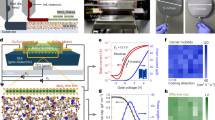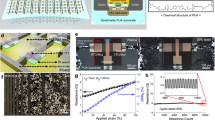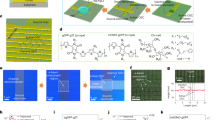Abstract
Field-effect transistors made of organic single crystals are ideal for studying the charge transport characteristics of organic semiconductor materials1. Their outstanding device performance2,3,4,5,6,7,8, relative to that of transistors made of organic thin films, makes them also attractive candidates for electronic applications such as active matrix displays and sensor arrays. These applications require minimal cross-talk between neighbouring devices. In the case of thin film systems, simple patterning of the active semiconductor layer9,10 minimizes cross-talk. But when using organic single crystals, the only approach currently available for creating arrays of separate devices is manual selection and placing of individual crystals—a process prohibitive for producing devices at high density and with reasonable throughput. In contrast, inorganic crystals have been grown in extended arrays11,12,13, and efficient and large-area fabrication of silicon crystalline islands with high mobilities for electronic applications has been reported14,15. Here we describe a method for effectively fabricating large arrays of single crystals of a wide range of organic semiconductor materials directly onto transistor source–drain electrodes. We find that film domains of octadecyltriethoxysilane microcontact-printed onto either clean Si/SiO2 surfaces or flexible plastic provide control over the nucleation of vapour-grown organic single crystals. This allows us to fabricate large arrays of high-performance organic single-crystal field-effect transistors with mobilities as high as 2.4 cm2 V-1 s-1 and on/off ratios greater than 107, and devices on flexible substrates that retain their performance after significant bending. These results suggest that our fabrication approach constitutes a promising step that might ultimately allow us to utilize high-performance organic single-crystal field-effect transistors for large-area electronics applications.
This is a preview of subscription content, access via your institution
Access options
Subscribe to this journal
Receive 51 print issues and online access
$199.00 per year
only $3.90 per issue
Buy this article
- Purchase on Springer Link
- Instant access to full article PDF
Prices may be subject to local taxes which are calculated during checkout




Similar content being viewed by others
References
de Boer, R. W. I., Gershenson, M. E., Morpurgo, A. F. & Podzorov, V. Organic single-crystal field-effect transistors. Phys. Status Solidi a 201, 1302–1331 (2004)
Briseno, A. L. et al. Patterned growth of large oriented organic semiconductor single crystals on self-assembled monolayer templates. J. Am. Chem. Soc. 127, 12164–12165 (2005)
Huitema, H. E. A. et al. Plastic transistors in active-matrix displays. Nature 414, 599 (2001)
Moon, H. et al. Synthesis, crystal structure, and transistor performance of tetracene derivatives. J. Am. Chem. Soc. 126, 15322–15323 (2004)
Podzorov, V. et al. Intrinsic charge transport on the surface of organic semiconductors. Phys. Rev. Lett. 93, 086602 (2004)
Pope, M., Charles, E. & Swenberg, C. E. Electronic Processes in Organic Crystals and Polymers (Oxford Univ. Press, New York, 1999)
Sundar, V. C. et al. Elastomeric transistor stamps: Reversible probing of charge transport in organic crystals. Science 303, 1644–1646 (2004)
Zeis, R. et al. Field effect studies on rubrene and impurities of rubrene. Chem. Mater. 18, 244–248 (2006)
Steudel, S., Janssen, D., Verlaak, S., Genoe, J. & Heremans, P. Patterned growth of pentacene. Appl. Phys. Lett. 85, 5550–5552 (2004)
De Vusser, S., Steudel, S., Myny, K., Genoe, J. & Heremans, P. Integrated shadow mask method for patterning small molecule organic semiconductors. Appl. Phys. Lett. 88, 103501 (2006)
Aizenberg, J., Black, A. J. & Whitesides, G. M. Controlling local disorder in self-assembled monolayers by patterning the topography of their metallic supports. Nature 394, 868–871 (1998)
Aizenberg, J., Black, A. J. & Whitesides, G. M. Control of crystal nucleation by patterned self-assembled monolayers. Nature 398, 495–498 (1999)
He, J. H. et al. Pattern and feature designed growth of ZnO nanowire arrays for vertical devices. J. Phys. Chem. B 110, 50–53 (2006)
van der Wilt, P. C., van Dijk, B. D., Bertens, G. J., Ishihara, R. & Beenakker, C. I. M. Formation of location-controlled crystalline islands using substrate-embedded seeds in excimer-laser crystallization of silicon films. Appl. Phys. Lett. 79, 1819–1821 (2001)
Vikas, R. et al. in Proc. International Electron Devices Meeting 2005 919–922. (IEEE International, 2005)
Kloc, C., Simpkins, P. G., Siegrist, T. & Laudise, R. A. Physical vapor growth of centimeter-sized crystals of alpha-hexathiophene. J. Cryst. Growth 182, 416–427 (1997)
Choi, H. Y., Kim, S. H. & Jang, J. Self-organized organic thin-film transistors on plastic. Adv. Mater. 16, 732–736 (2004)
Ruiz, R. et al. Pentacene thin film growth. Chem. Mater. 16, 4497–4508 (2004)
Heringdorf, F., Reuter, M. C. & Tromp, R. M. Growth dynamics of pentacene thin films. Nature 412, 517–520 (2001)
Markov, I. V. Crystal Growth for Beginners (World Scientific, Singapore, 2003)
Venables, J. A., Spiller, G. D. T. & Hanbucken, M. Nucleation and growth of thin films. Rep. Prog. Phys. 47, 399–459 (1984)
Granasy, L., Borzsonyi, T. & Pusztai, T. Nucleation and bulk crystallization in binary phase field theory. Phys. Rev. Lett. 88, 206105 (2002)
Granasy, L. et al. Phase field theory of crystal nucleation and polycrystalline growth: A review. J. Mater. Res. 21, 309–319 (2006)
Verlaak, S., Steudel, S., Heremans, P., Janssen, D. & Deleuze, M. S. Nucleation of organic semiconductors on inert substrates. Phys. Rev. B 68, 195409 (2003)
Kelley, T. W. et al. Recent progress in organic electronics: Materials, devices, and processes. Chem. Mater. 16, 4413–4422 (2004)
Klauk, H., Gundlach, D. J., Nichols, J. A. & Jackson, T. N. Pentacene organic thin-film transistors for circuit and display applications. IEEE Trans. Electron Devices 46, 1258–1263 (1999)
Klauk, H. et al. High-mobility polymer gate dielectric pentacene thin film transistors. J. Appl. Phys. 92, 5259–5263 (2002)
Briseno, A. L. et al. High-performance organic single-crystal transistors on flexible substrates. Adv. Mater. 18, 2320–2324 (2006)
Acknowledgements
A.L.B. acknowledges a Bell Labs Graduate Research Fellowship. A.L.B., F.W., R.J.T. and Y.Y. acknowledge financial support from the Air Force Office of Scientific Research (AFOSR). S.C.B.M. acknowledges financial support from the Deutsche Forschungsgemeinschaft, and Z.B. acknowledges partial support from the Stanford Center for Polymeric Interfaces and Macromolecular Assemblies (NSF-Center MRSEC), the Stanford School of Engineering, and a Sloan Research Fellowship. Author Contributions A.L.B. performed single-crystal patterning on substrates and FET devices, measurements on FET devices, and wrote most of the manuscript. S.C.B.M. elucidated the growth mechanism, performed AFM measurements, and wrote parts of the manuscript. M.M.L. assisted in sample preparation and assisted in device measurements and calculations. S.L. assisted in crystal patterning, device preparation, and performed SEM measurements. R.J.T. assisted in flexible device preparation, measurements and calculations. C.R. designed and fabricated the transistor array devices and PDMS stamp masters via lithography. M.E.R. assisted in early experiments and purified some of the organic source materials. Y.Y. provided use of laboratory space and instruments. F.W. provided feedback and suggestions on experiments. Z.B. conceptualized and directed the research project. All authors discussed the results and commented on the manuscript.
Author information
Authors and Affiliations
Corresponding author
Ethics declarations
Competing interests
Reprints and permissions information is available at www.nature.com/reprints. The authors declare no competing financial interests.
Supplementary information
Supplementary Notes
This file contains Supplementary Notes with a more detailed description of the method, additional experimental data on the organic single crystals morphology and corresponding transistor performance, and supporting evidence for the proposed nucleation mechanism, including 20 new Supplementary Figures some of which are referenced from within the main text . (PDF 6243 kb)
Rights and permissions
About this article
Cite this article
Briseno, A., Mannsfeld, S., Ling, M. et al. Patterning organic single-crystal transistor arrays. Nature 444, 913–917 (2006). https://doi.org/10.1038/nature05427
Received:
Accepted:
Issue Date:
DOI: https://doi.org/10.1038/nature05427
This article is cited by
-
Lateral epitaxial growth of two-dimensional organic heterostructures
Nature Chemistry (2023)
-
Self-organized patterning on azo molecular glass film via optical near-field effect
Communications Materials (2023)
-
Template-Assisted Fabrication of Single-Crystal-Like Polymer Fibers for Efficient Charge Transport
Advanced Fiber Materials (2023)
-
Generalised optical printing of photocurable metal chalcogenides
Nature Communications (2022)
-
Charge carrier mobilities of organic semiconductors: ab initio simulations with mode-specific treatment of molecular vibrations
npj Computational Materials (2022)
Comments
By submitting a comment you agree to abide by our Terms and Community Guidelines. If you find something abusive or that does not comply with our terms or guidelines please flag it as inappropriate.



